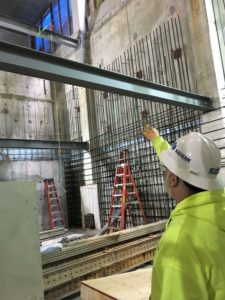Kadean Construction has begun building a 48,000-cubic-foot, underground concrete vault to house a 120 ton cyclotron for Siteman Cancer Center’s second proton treatment facility in St. Louis, Missouri.
The vault is being built beneath a parking garage on the Washington University Medical Campus, which also includes Barnes-Jewish Hospital and St. Louis Children’s Hospital, in the city’s Central West End.
 When completed in mid-to-late 2019, the 40-foot deep vault will house the massive cyclotron, which will produce a focused beam of isolated protons for “pencil-beam scanning,” an advanced form of radiation therapy for patients treated at the S. Lee Kling Proton Therapy Center at Siteman.
When completed in mid-to-late 2019, the 40-foot deep vault will house the massive cyclotron, which will produce a focused beam of isolated protons for “pencil-beam scanning,” an advanced form of radiation therapy for patients treated at the S. Lee Kling Proton Therapy Center at Siteman.
The total cost of the project is $32 million, including $17 million for the cyclotron and related infrastructure provided by Mevion Medical Systems.
The underground proton vault will be 30 feet wide, 40 feet long and 40 feet tall, and made mostly of high-density concrete with walls that are four-foot thick, said Matt Breeze, vice-president of Kadean Construction.
Upon completion, the finished patient treatment room will be located in the middle of what is now a cavernous, three-story area. The massive cyclotron and its infrastructure will encompass the treatment room, although it will never be seen by patients or the doctors.
 “This is a very complex project,” Breeze said. “We had to dig all the way to bedrock, and then we had to excavate and remove three-to-six feet of bedrock, which serves as the foundation for the concrete floor and the walls of the vault.”
“This is a very complex project,” Breeze said. “We had to dig all the way to bedrock, and then we had to excavate and remove three-to-six feet of bedrock, which serves as the foundation for the concrete floor and the walls of the vault.”
This will be the second proton therapy vault constructed by Kadean at Siteman Cancer Center. In 2011, Kadean finished constructing Siteman’s first proton vault which, at the time, was the first of its kind in the world. Siteman began treating patients with the first system in 2013. The second vault is immediately adjacent to the first one, which provides some logistical challenges because the construction site has very limited space in which to work or free access for heavy construction equipment.
The first vault, which also houses a Mevion cyclotron, is slightly smaller, Breeze said. And, like the second vault, its walls are four-feet thick and made with high-density concrete.
“We learned a lot when we built the first vault,” Breeze said. “The site traffic and logistics are fairly complicated because we had to tackle our work without interrupting the constant flow of patients and hospital deliveries, just as we always do in all medical construction.”
He added that other proton vaults have been built with 14-foot-thick walls for radiation containment.
“Because of the confined area we had to work with when we built the first vault, however, our walls could only be four feet thick,” he said. “The design team solved the problem by using Hematite, a heavy, iron ore aggregate mined in Brazil and shipped to St. Louis.”
Breeze said the high-density concrete used for both vaults weighs 250 pounds per cubic foot dry density, whereas regular concrete is about 150 pounds per cubic foot.




